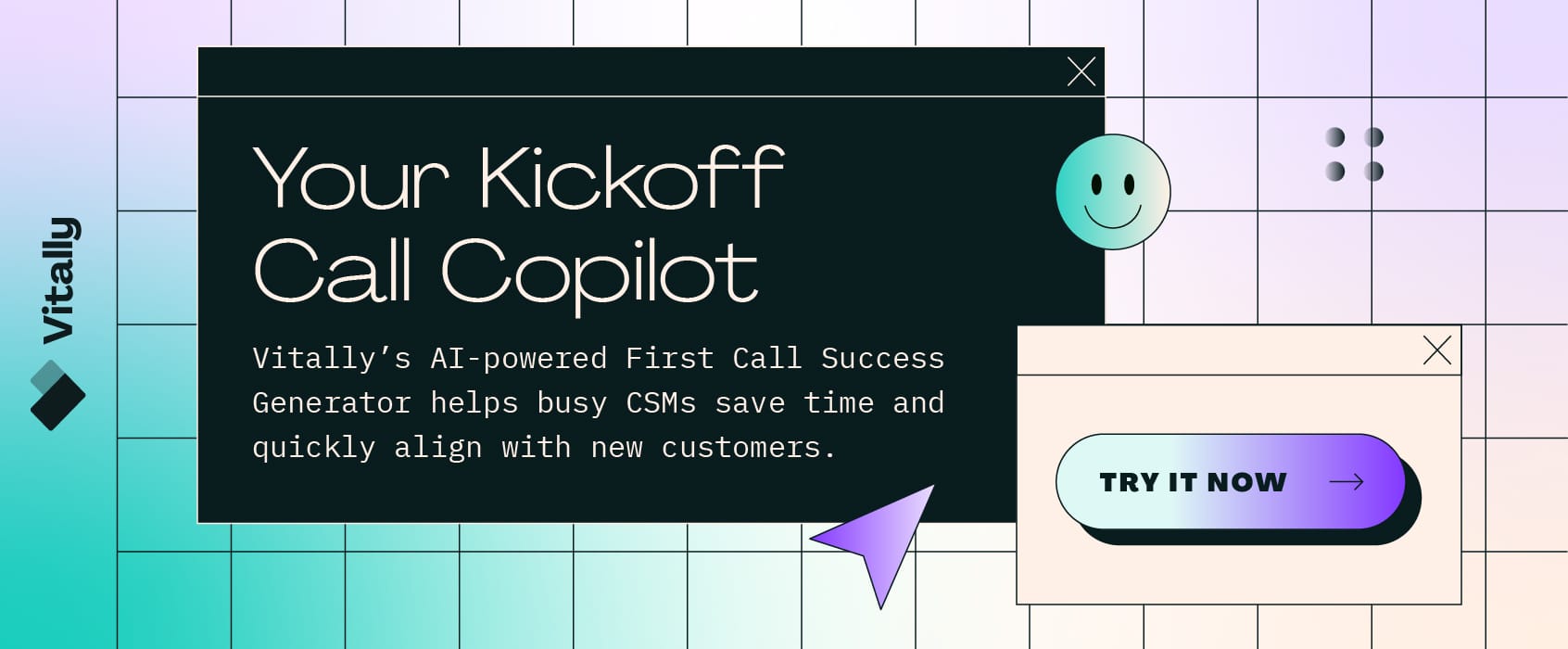
In customer success, we deal with overconfidence bias every time a new deal is closed. Any talk of the future relationship is about goals and outcomes, all glass-half-full conversations. And while we do conduct risk analyses, we do so after the fact, hoping to apply the learnings of a churned customer to one with an entirely different business model.
Doing that, we learn why our customer relationships died, but not how to save the next ones. What’s needed is a framework that identifies churn risks as soon as you sign a new customer, so you can create a plan to deal with those risks when they surface.
Never Miss a Churn Risk
See how Vitally can help your Customer Success team stay on top of churn risks with indicators that fire automatically
Here’s some really good news. Project managers already have the perfect framework for the job. It’s called a premortem, and with it, PMs confidently predict all the reasons their project will fail, without waiting for those failures to happen.
Imagine what that kind of foresight could do for you. If you could look into the future and know why a customer quit, you could create a disaster plan that went into effect as soon as it started happening. That way, you’d be prepared to stop churn before it happens, instead of watching your new customer disappear in a flash.
The Gaps in Churn Analysis and Customer Success Plans

There are two playbooks SaaS companies use to make sure a customer is successful: churn analysis and customer success plans. Both frameworks are useful, but on their own, they leave a significant gap in preventing churn.
In a churn analysis, you dissect a customer relationship that has soured to the point of failure. Your review might net some good data, but you don’t get that data until you’ve lost a customer.
A customer success plan is forward-thinking, so it beats a churn analysis in that way. However, a success plan is focused only on goals and ways to achieve them. There is nothing in the plan that addresses inherent risks to the relationship. It’s like a business plan that hasn’t considered the threat of disruptive technologies.
What’s missing is a playbook that identifies high-probability risks at the beginning of a new customer relationship.
The Risk-Predicting Premortem Playbook
Premortem (n.)
A group exercise that asks you and your team to (1) assume a customer relationship has failed and (2) imagine all the reasons why it might have happened.
Premortems require you to ask, “why did this fail?” instead of asking, “why might this fail?” That subtle difference is the secret sauce of a premortem. By pretending that a customer already churned, a premortem tricks our brains into processing that event like a memory. The theory behind it is called prospective hindsight, and it’s been shown to boost our chances of predicting why future events happen by 30%.
Once you know why something is going to happen, you can prepare a plan to either avoid it or at least mitigate its effects. For example, if you believe a product champion is a flight risk, you can be extra diligent in making more connections throughout your customer’s organization.


Using a Premortem to Improve Customer Retention
One of the benefits of a premortem is that it doesn’t take up a lot of resources. All you need is your team, 60 minutes, and a way to take notes.
Ditch the Pen and Paper
See how Vitally makes taking collaborative, actionable customer notes easier than ever
Teamwork Makes the Precognition Work
Groups are better at finding answers than people working solo, especially in an exercise like this, where you’ll benefit from a range of expertise. So invite a cross-functional team from Sales, Product, Marketing, and Customer Success to the premortem party. Bonus: Each team will walk away with new insights about what makes customers successful.
Plan to fail
The fear of being the lone voice of negativity is well documented—no one wants to be the downer who points out weaknesses in a new customer relationship. A premortem shatters that fear by requiring each participant to provide reasons why a customer has churned.
Want to make the most out of your premortem? See how Vitally arms your Customer Success team with data so your conversations stay focused on real information (not gut feelings).
Begin your premortem by setting the stage. Tell everyone it’s six months from now, and your shiny new customer has just churned. It’s their job to write down three reasons why it happened.
Give the group 15 minutes, but before they get started, set the expectation that no idea is out of bounds. You can hammer that point home by writing one wild idea on the board, like the customer’s HQ was hit by a falling spaceship. Anything more likely than that is acceptable.
Once everyone has created their list, go around and have each person call out a churn risks (even if someone else has already said it!). Write it on a whiteboard. Repeat this until all the churn risks are on the board. (We suggest taking no more than 15 minutes for this step.)
Filter for Probability, Action-Ability, and Level of Risk
Spend the next 15 minutes paring down your list using three filters.
- Probability: Remove risks that are really unlikely (like the falling spaceship)
- Action-ability: Remove churn risks that you can’t control or mitigate, no matter how well you plan (like if your customer went out of business)
- Level of risk: Look at what's remaining and pick the five that will most likely cause churn. Will the delay of a new product launch be a minor annoyance, or will it cause your new customer to look for other solutions?
Prepare for the Worst
It's time to roll up your sleeves and create an action plan that either avoids each churn risk or mitigates its effect. Suppose your new customer isn’t very tech savvy. You can keep them from churning by adding educational steps in their onboarding process.
Is Your Customer Success Automation Building Trust or Breaking It?
With Vitally's powerful playbooks, you can give your CSMs more time to focus on building relationships that count. All without losing that oh-so-important personal touch.
Put your plan in action! Make sure each plan has a person, a due date, and a follow-up procedure assigned to it. We recommend using the RACI matrix outlined here >>
With churn risks clearly identified and a plan in place to address each one, you’ll be prepared to quickly respond and increase the chances of retaining your new customer.
Improving All Customer Retention with Premortems
Premortems are best done in a 1:1 CS model for high-value customers, but they can help your team reduce churn risk for the entire customer base. That’s because the premortem process will teach your CSMs a new way to think about churn prediction and prevention.
After some practice, all your CSMs will be able to hold a simplified premortem for every customer they manage, leaving them better prepared to react when a churn risk appears (just so long as there's no falling spaceships involved).









